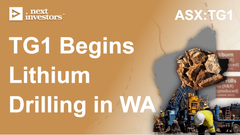We attended the ASIC conference - here is what we learned
- Commentary: We attended the ASIC conference - here is what we learned. Quick update on stocks. Reply if you know any good WA lithium explorers.
- Quick Takes: GAL, GGE, EMD, GTR, OJC
- This week in our Portfolios: TG1, EMD
- Updates on upcoming share price catalysts.
Remember when we thought IVZ and NHE might deliver their long awaited oil & gas drill results on the same day?
It looked to us like they both might announce just before Melbourne Cup day, about 3 weeks ago...
Well, that certainly didn’t happen.
We are STILL waiting for both to announce the final results, due to the various delays and issues that usually happen with frontier oil & gas exploration and results analysis.
Both IVZ and NHE are now guiding the market to expect the big news in December.
In the grand scheme of things, a few more weeks isn't very long, especially considering we have been waiting for these results for a few years now.
Taking what positives we can out of the delays, a bit of speculative heat has now come out of both IVZ and NHE share prices, which sets things up for a better share price reaction if they deliver the goods (we are still holding our entire positions).
EXR started drilling its oil & gas well two weeks ago and is making quick progress, now at 2,915m drilled depth out of a planned 4,200m.
EXR also looks on track to deliver the biggest pre-drill results share price run out of our three “pre christmas” drillers.
The EXR share price has been quietly creeping up over the two weeks since drilling started from under 6c to hit 9.9c yesterday.
Hopefully, it will continue for the next couple of weeks before the results are announced.
Lithium in Western Australia - reply if you know any good WA lithium explorers we should look at
Western Australia is one of the top mining jurisdictions in the world.
We have clearly been in a “lithium boom” over the last few years.
With the lithium speculation cooling over the last 12 months, big mining companies and billionaires mining investors who believe in long term lithium demand have now started to try and buy up lithium projects in WA.
They appear to have decided that the tried and tested mining region of WA is the most likely place where lithium projects will actually become lithium mines in the future.
Major lithium producers all over the world have their eyes on the big discoveries across WA.
Albermarle tried a $6BN takeover of Liontown, and SQM a $1.6BN takeover of Azure Minerals.
The Aussie billionaires Chris Ellison and Gina Rinehart also joined the party and have been buying up stakes in the same projects.
The precedent set by the ones with deep pockets is that any sniff of a lithium hit could be next... and market caps can move very fast.
Here’s a reminder of the most notable developments across WA:
- Azure Minerals up ~1,400%
- Raiden Resources up ~1,700%
- TG Metals up ~700%
- Wildcat Resources up ~ 2,600%
- Liontown Resources takeover offer
- Azure Minerals takeover offer
- Allkem merger with Livent
- And most recently, Rio Tinto’s deal with Charger Metals
Our Investment TechGen Metals (ASX:TG1), has joined the WA lithium scene after it stumbled on some lithium in soil samples from exploration work done on its gold project.
After a site visit this week, TG1 announced that it had found a giant 800m x 400m field of pegmatites, and rock samples collected are now at the lab to be assayed for lithium content...
TG1 expects to be drilling in January.
Consolidation of WA lithium projects over the next year or two
Last week we listened to the Mineral Resources AGM, and it appears all the M&A activity in WA lithium is pointing to a much bigger consolidation grand plan by a few of the major players.
Meaning that successful lithium explorer could be rewarded with an acquisition by a major, or a merger with a bigger company (investors get stock in the combined entity).

(Source)

(Source)
This level of activity (and money) in the WA lithium sector has led us to seek two more WA lithium explorers to add to our portfolio to hold during 2024.
Preferably the project is:
- close to a bigger project, existing discovery or current lithium mine,
- sub $10M market cap (sub $5M even better) and
- close to starting a drilling campaign.
Our view is that new discoveries closer to existing producing hubs will be the ones that re-rate the strongest and so we want to try and get some exposure in good projects in strong neighbourhoods.
Early stage explorers are high risk, so the plan is to make a few Investments and hope that one makes a discovery and gets swept up in the consolidation of WA lithium projects we anticipate in 2024.
If you know of any WA lithium explorers that fit the above criteria, please reply to this email and let us know.
We attended the ASIC annual conference this week.
Next Investors has operated under an Australian Financial Services License (AFSL) for over 10 years.
Part of operating under an AFSL is staying up to date and compliant with any new regulations or updated guidelines that come from ASIC every year.
We attended the ASIC conference this week, which was a good place to hear about the current state of the Australian financial markets, what the government's economic priorities are, how ASIC plans to help the government achieve its goals and what are ASIC’s priority focus areas over the next 12 months.
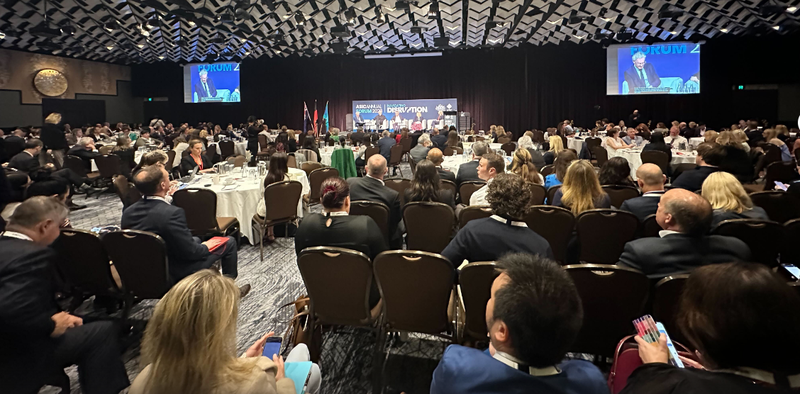
ASIC (the Australian Securities and Investments Commission) is the Australian financial markets conduct regulator.
They are effectively the “police” that enforce the rules that help financial markets operate.
ASIC’s role is to give investors both domestically and abroad, confidence and trust in the Australian capital markets system.
The “financial markets” are where buyers and sellers come together to trade stocks, bonds, currencies and many other financial products and services.
The role of the regulator (in Australia this is ASIC) is to enforce rules and regulations and ensure that market participants are not breaching these rules to the detriment of consumers.
ASIC’s remit covers a broad range of areas, including directors' duties, superannuation, consumer lending and the stock market.
The focus of the conference was that the world is changing every day, and the regulator needs to adapt to this change.
Here are our key takeaways from the conference:
Strategy for Australia: Jim Chalmers, Treasurer
Jim Chalmers, the Australian Treasurer, opened the day with a broad discussion on Australia’s outlook and the government’s strategy to tackle the biggest issues facing Australians.
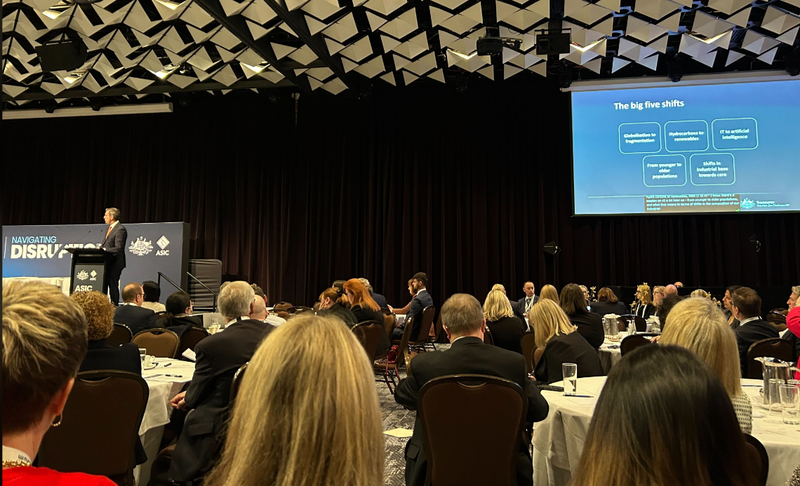
In particular, cost of living, inflation, the energy transition, productivity and security.
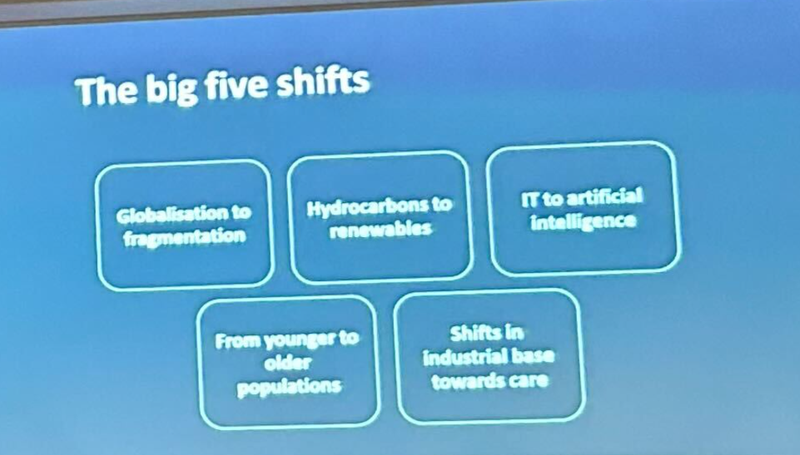
(Sorry for blurry photo)
The Treasurer presented and broke down the government’s strategy, summarised in the following slide:
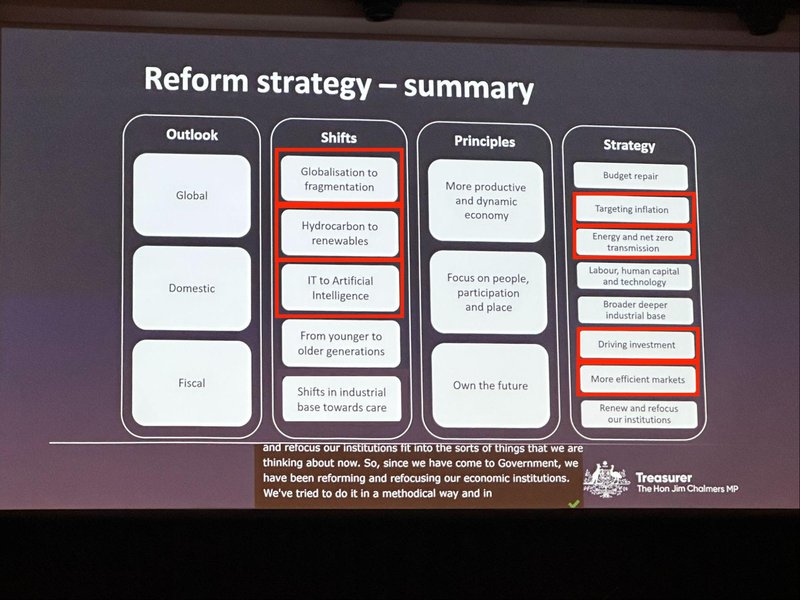
We’ve highlighted the global shifts that directly affect our Investment Portfolio, in particular, the fragmentation of supply chains and the move to renewable energy.
Our take is that the government still has a big focus on taming inflation and will continue to enact policies that drive inflation down - however, are still acutely aware of the opportunities that Australia has in the energy and technology sector.
Opening Address: Joseph Longo, Chair ASIC
Joe Longo opened the address by highlighting the need for the regulator to respond to rapid disruption in the financial markets from new technologies - and how to best design, deploy and enforce regulations.
Think of new financial innovations like cryptocurrency, “finfluencers” on social media, high frequency trading algorithms and artificial intelligence.
New technologies where updated regulations need to be created and enforced.
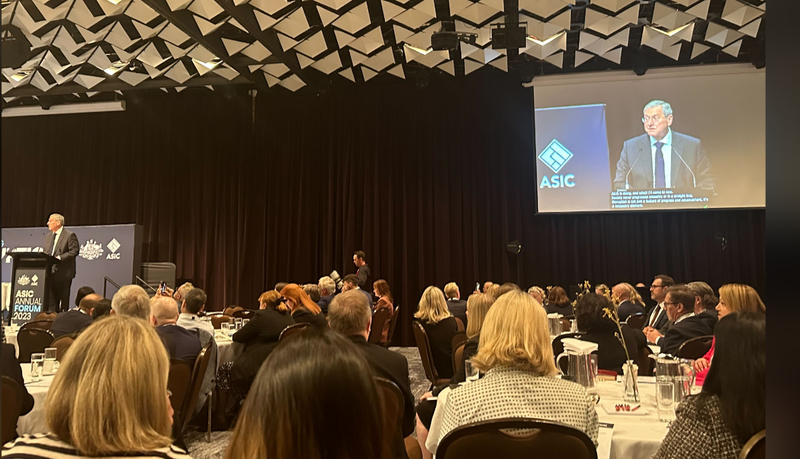
Joe’s position is that innovation in finance is a good thing.
Joe talked about the “policy trilemma” of ASIC when dealing with regulating new innovations in the financial markets.
A trilemma is like a dilemma, but instead of it being a difficult choice between two options, it’s a choice between three options.
Joe talked about how the role of ASIC is to carefully balance the releasing of new rules and regulations, enforcing those new rules and regulations while maintaining an environment that doesn’t stamp out innovation in the financial markets.
Joe outlined that ASIC’s policy “trilemma” is that it’s generally only possible to choose two out of the three items shown in the triangle below.
You can't have all three, so ASIC tries to strike a balance:
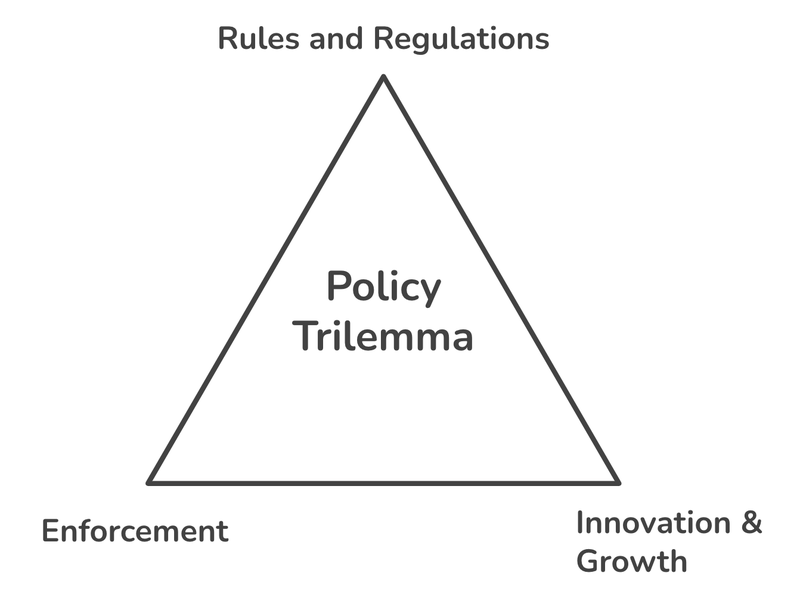
For example, too many rules and regulations with too much enforcement will dampen financial innovation.
Or you can have rules and regulations, but being too light on enforcement could lead to uncontrolled innovation that can lead to harmful products (like the crypto scams we saw over the last couple of years).
Balancing each corner of this “trilemma” explains some of ASIC’s approach to how they implement and enforce regulations for new financial products.
State of the Economy
There were some heavy hitters in the first panel discussion, including RBA Governor Michele Bullock, Dr Raphael Arndt, CEO of the Future Fund and Danielle Wood, Chair of the Productivity Commission.
The panel spoke about how, right now, every country is fighting for capital, to fund its decarbonisation efforts and achieve energy independence.
However, this effort is met with inflationary headwinds stalling efforts.
Thus, the key goal of the RBA and the government is to tackle inflation, so that Australia can get back on track with its energy transition.
Enforcement priorities of ASIC
Sarah Court, the deputy chair of ASIC spoke about the broad remit of areas that ASIC is looking to tackle in 2024:
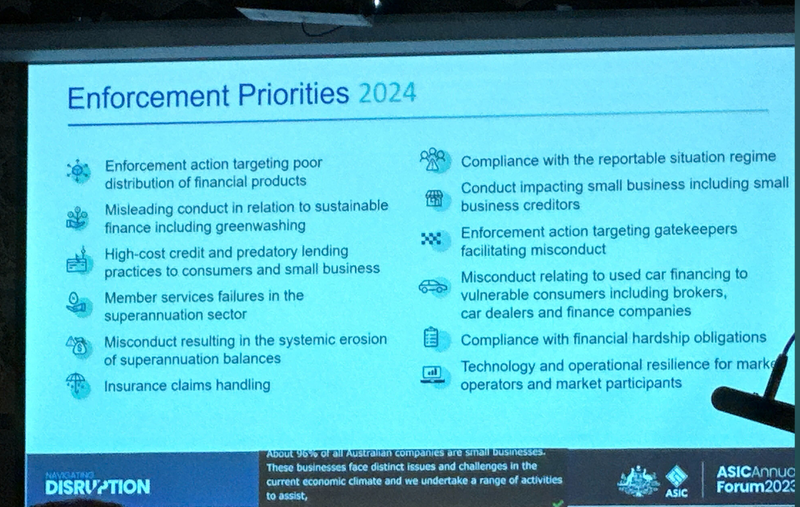
But at its core, the “Enduring Priorities” of the regulator are still the standard areas expected of a financial regulator:
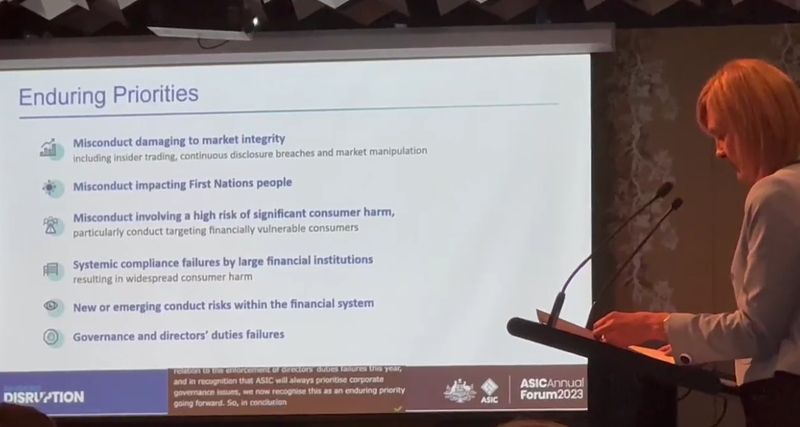
It was interesting in this session to listen to a high level discussion of why regulations exist and how ASIC uses a number of different deterrents to get the best market outcomes while managing its resources.
Navigating disruption: Regulator Perspectives
In this panel session, we heard from the heads of ASIC, the Australian Prudential Regulatory Authority (APRA), the Australian Competition and Consumer Commission (ACCC) and the Australian Transaction Reports and Analysis Centre (AUSTRAC).
APRA is Australia’s prudential supervisor, responsible for ensuring that our financial system is stable, competitive and efficient.
ACCC is Australia's national competition, consumer, fair trading and product safety regulator.
AUSTRAC is an Australian government financial intelligence agency responsible for monitoring financial transactions to identify money laundering, organised crime, tax evasion, welfare fraud and terrorism financing.
The panel discussed how they are dealing with the new technology disruptions happening in the financial markets.
It was commonly agreed that artificial intelligence poses some significant new challenges for regulators to keep up with.
On the flip side, artificial intelligence provides many opportunities to assist regulators in processing large amounts of data to detect where misconduct may be occurring.
Each institution on the panel is currently exploring the use of AI in their activities.
Digital Innovation in Financial Markets
In this panel, we heard from the CEO of clearing house Finclear, the CEO of issuer services from Computershare (Aust and NZ) and the executive director of market services from ASIC.
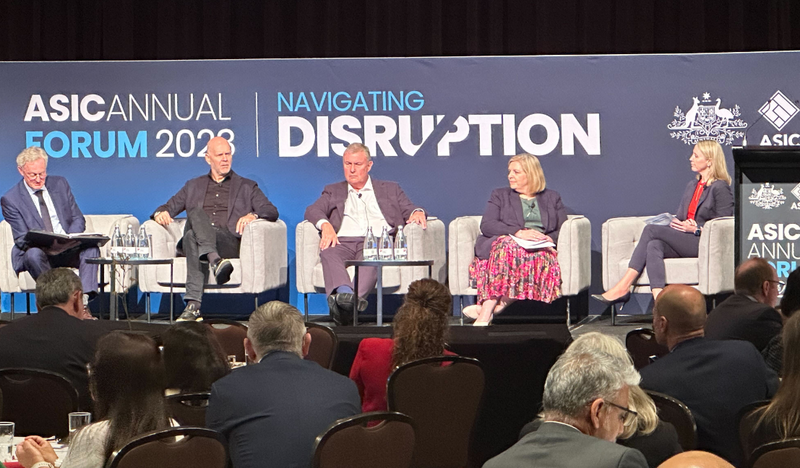
The panel started with a history of how the stock market started using technology and hence becoming more regulated.
The major talking point was how innovation in trading technology leads to more participation in financial markets and more unrelated innovation on the fringes of markets.
Examples like how the move from telephones to personal computers had a significant impact on trading volumes and frequency.
There were two big events that increased public participation in the markets over the last 30 years.
In the mid 90’s there were many “demutualisations” in Australia.
A “demutualisation” is where an ownership structure called a “mutual” converts into a corporation with shares (like the ones we are used to investing in), meaning that all the “mutual” members become shareholders in a new corporation...
In a “mutual”, ownership comes from membership based on acquiring a product or service from the company, rather than by contributing capital. Consequently, members typically cannot trade their interests in the mutual.
As a rough example, think of it like suddenly getting shares in Netflix because you have a Netflix account (assuming for this example that Netflix is a mutual, which it isn’t).
The string of demutualisations in the 90’s saw millions of Australian “mums and dads” become shareholders for the first time in their lives, and it was the first stock they ever held.
This was the first wave of increased market participation by retail investors.
It was stated that 60% of people who received shares from the demutualisation in the 90’s still hold them today, and it is what has shaped the market to initially recognise retail investors.
At that time, annual reporting was lacking in detail, it was essentially just a “concise page” sent to every investor.
“Regulation merged with common sense” and communications to broader investors began to improve and became more focused on retail investors, and then came improvements in self service for trading
(This was before our time, we didn’t know this history, and it was certainly interesting to learn about it.)
Fast forward 30 years.
The second major wave of new retail market participants came during the COVID pandemic, when interest rates were zero and people were locked in their houses and learning about the share market was something to do.
This was one we all definitely lived through.
The stats around the market participation influx during COVID show that almost 25% of current stock market participants started in the last two years, many are below 25 years old and lots of them are trading in ETFs.
We note that the panel and the regulators considered increased market participation a good thing and actually want to encourage more people learning about and getting involved in the financial markets.
With this increased market participation, the discussion then moved on to how new areas of concern are identified and then regulated.
It appears that much of it is driven by what is happening in mature financial markets overseas.
Generally regulators will identify what’s happening abroad and how the regulations are evolving and bring those ideas to Australia.
Currently ASIC is looking at “dark pools”, high-frequency trading and “paying for order flow” (like in some new trading apps).
Some positive new innovations in the overseas markets expected to come to Australia soon include:
- Moving from paper certificates to digital certificates for asset ownership
- T+2 to T+1 (US and Canada are doing it)
Artificial Intelligence in financial markets was a key theme during the whole conference.
One slightly scary thing shared by a panel member was a recent quote from the SEC chairman (USA’s version of ASIC) who reckons the next financial crisis is going to be caused by AI:
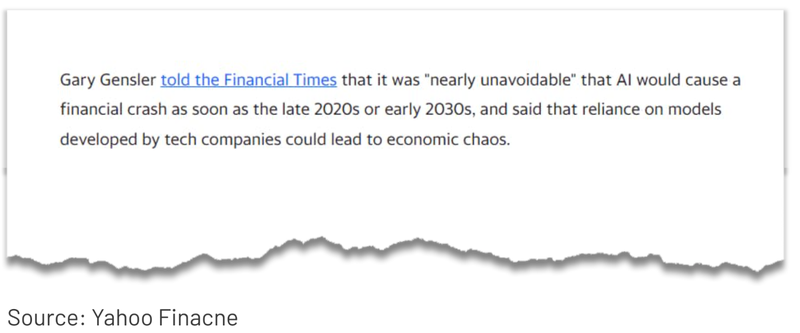
(Source)
...sounds like he’d better get regulating asap.
What we wrote about this week 🧬 🦉 🏹
WA lithium: TG1 announces 800m x 400m pegmatite field - bigger than a large sports stadium
On Tuesday, TG1 announced they have identified an 800m x 400m pegmatite field which is open in all directions - a field the size of 12 MCGs. TG1’s WA lithium project is near $297M Delta Lithium which is 50 km to the south and $3.5BN Liontown Resources which is 100 km north.
EMD first mover in psychedelic care market
EMD has just signed on a new chairman, Greg Hutchinson, who led the scale up of Sonic HealthPlus to over 7,000 active clients across 40 different clinic locations. And a few weeks ago, our Investment EMD treated its first patient using psychedelics for mental health issues in a private clinic. We think Hutchinson is the perfect person to help EMD scale the company’s clinics.
Quick Takes 🗣️
GAL - Geophysics surveys complete and results
GGE planning to re-enter US helium well next month
EMD gets a new Non-Executive Chair...
GTR currently drilling for Uranium in the USA - more drill targets identified
OJC - PFD Foods’ owner Invests $5M
Bite sized summaries of the latest mainstream news in battery metals, biotechs, uranium etc: The Future Money: https://future-money.co/
⏲️ Upcoming potential share price catalysts
Updates this week:
- EXR: Daydream-2 appraisal well, QLD
- EXR reached 2,915m of a target 4,200m depth at its well. See the ASX announcement here.
- IVZ: Drilling oil & gas target in Zimbabwe, Mukuyu-2 (Q3, 2023)
- IVZ announced that it would start drilling a Mukuyu-2 sidetrack well. At the same time, the company confirmed hydrocarbons had been recovered to the surface from the shallower Pebbly Arkose targeted. See the ASX announcement here.
No material news this week:
- 88E: Flow test well, Alaska (Q1, 2024) & Government approvals for Namibia project (Q1, 2024)
- NHE: Drilling two targets at its helium project in Tanzania (Q4, 2023)
- TYX: Second round of drilling at lithium project in Angola
- PUR: Drilling its Argentine lithium project in Q4-2023.
- SLM: Assay results from drilling at its Brazilian Lithium project.
- DXB: Interim Analysis of Phase III Clinical Trial on FSGS (March 2024)
Have a great weekend,
Next Investors
General Information Only
S3 Consortium Pty Ltd (S3, ‘we’, ‘us’, ‘our’) (CAR No. 433913) is a corporate authorised representative of LeMessurier Securities Pty Ltd (AFSL No. 296877). The information contained in this article is general information and is for informational purposes only. Any advice is general advice only. Any advice contained in this article does not constitute personal advice and S3 has not taken into consideration your personal objectives, financial situation or needs. Please seek your own independent professional advice before making any financial investment decision. Those persons acting upon information contained in this article do so entirely at their own risk.
Conflicts of Interest Notice
S3 and its associated entities may hold investments in companies featured in its articles, including through being paid in the securities of the companies we provide commentary on. We disclose the securities held in relation to a particular company that we provide commentary on. Refer to our Disclosure Policy for information on our self-imposed trading blackouts, hold conditions and de-risking (sell conditions) which seek to mitigate against any potential conflicts of interest.
Publication Notice and Disclaimer
The information contained in this article is current as at the publication date. At the time of publishing, the information contained in this article is based on sources which are available in the public domain that we consider to be reliable, and our own analysis of those sources. The views of the author may not reflect the views of the AFSL holder. Any decision by you to purchase securities in the companies featured in this article should be done so after you have sought your own independent professional advice regarding this information and made your own inquiries as to the validity of any information in this article.
Any forward-looking statements contained in this article are not guarantees or predictions of future performance, and involve known and unknown risks, uncertainties and other factors, many of which are beyond our control, and which may cause actual results or performance of companies featured to differ materially from those expressed in the statements contained in this article. S3 cannot and does not give any assurance that the results or performance expressed or implied by any forward-looking statements contained in this article will actually occur and readers are cautioned not to put undue reliance on forward-looking statements.
This article may include references to our past investing performance. Past performance is not a reliable indicator of our future investing performance.



